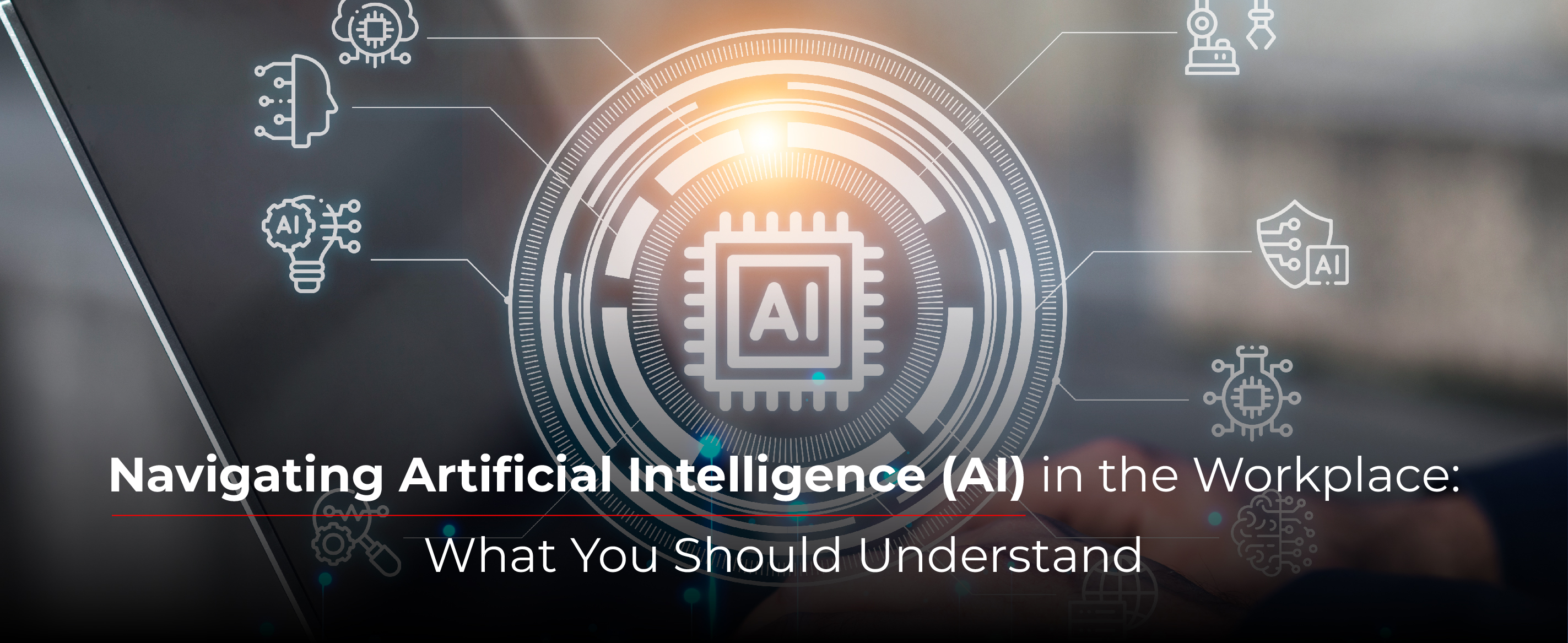
While the incorporation of artificial intelligence (AI) into the workplace is relatively recent, it has already become a prominent topic of discussion. Amidst sensational headlines about “robots taking over,” employees often harbor concerns about their job security, fearing that AI may replace them. Some are also apprehensive about the unknown and resistant to the changes associated with the adoption of new technology.
In this discussion, we will emphasize that employees need not dread AI, and companies should not procrastinate in addressing this issue and devising their AI integration strategies. AI is pervasive in the workplace and will play a substantial role in the future of work.
Rather than fearing AI, employees who adapt effectively will find more opportunities and job security. Similarly, companies that responsibly and thoughtfully embrace AI will gain a competitive advantage.
Understanding AI: Exploring Its Capabilities and Workplace Applications
AI, or Artificial Intelligence, encompasses a wide range of technologies capable of performing tasks that were traditionally the exclusive purview of human intelligence. These tasks include:
- Processing extensive volumes of data.
- Synthesizing and amalgamating information.
- Identifying and discerning patterns and trends.
- Solving intricate problems.
- Interpreting spoken language.
- Responding to queries.
- Making informed decisions.
- Recommending actions.
AI manifests itself through various forms, encompassing software programs, sensors, algorithms, analytics, machine learning, virtual assistants, robotics, and generative AI (commonly known as chatbots), among others.
Currently, some of the most prevalent AI tools utilized in workplaces are chatbots like:
- OpenAI ChatGPT.
- Microsoft Bing Chat.
- Google Bard.
These chatbots, upon receiving user prompts, autonomously furnish comprehensive answers to questions and generate content across multiple media formats, including text, images, audio, and video.
Workplace AI finds application in various scenarios, such as:
- Aiding in research across diverse subjects.
- Crafting a wide array of content, ranging from articles to social media posts.
- Generating responses for emails or chat interactions on collaborative platforms.
- Serving as an office assistant, performing tasks like setting reminders, reading emails aloud, or scheduling meetings.
- Facilitating swift retrieval of company information and documentation.
- Translating company materials into different languages.
- Transcribing meeting notes and extracting salient information into concise summaries.
- Conducting in-depth analysis.
- Scenario modeling.
The Intersection of Human Resources (HR) and Artificial Intelligence (AI)
AI plays a substantial role within HR, and this integration has been ongoing for some time. This is exemplified in various ways:
- Recruitment Benefits: AI aids recruiters by screening resumes to identify candidate attributes objectively, contributing to blind hiring and fostering a more diverse workforce.
- Streamlined Applicant Tracking: Applicant tracking systems autonomously manage candidates throughout the recruitment process, enhancing efficiency.
- Automated Onboarding: Much of the onboarding process, spanning paperwork and benefits selection, can be fully automated through AI.
- Learning and Development Support: AI assists learning and development initiatives by detecting knowledge gaps, tailoring content based on specific factors, and collecting data on outcomes and effectiveness.
- Employee Data Management: AI is instrumental in managing digital employee records and tracking relevant employee data.
- Virtual Chatbots: Virtual chatbots serve as customer service representatives, addressing employees’ daily queries and needs with efficiency.
Furthermore, the field of people analytics, which involves collecting HR and organizational data and converting it into actionable insights, is advancing rapidly. This information is invaluable for shaping organizational strategy, making informed hiring decisions, pinpointing potential issues, and future-proofing the workforce. AI significantly enhances the sophistication and precision of a company’s analytics efforts.
Numerous HR technologies exist to facilitate these AI-driven endeavors.
Advantages of AI
AI offers numerous valuable benefits to businesses, encompassing:
- Optimization of Work Processes: AI can optimize work processes, and in certain instances, fully automate them.
- Improved Decision-Making: It aids in making more informed decisions.
- Time Savings: AI saves personnel time by handling repetitive tasks.
- Enhanced Productivity: It boosts overall productivity within the organization.
- Focus on Value-Adding Tasks: Employees can shift their focus from routine tasks to more complex, impactful, or revenue-generating activities.
- Enhanced Communication and Collaboration: AI fosters better communication and collaboration among teams.
- Creative Boost: It contributes to increased creativity in problem-solving and innovation.
- Reduced Human Error: AI minimizes the occurrence of human errors in various processes.
- Cost Efficiency: In some cases, AI helps in cost reduction.
In today’s highly competitive job market, these advantages directly translate into a superior employee experience, elevated morale, increased workforce engagement, and extended employee retention.
Key Considerations
While AI can bring numerous positive impacts to the workplace, employers must exercise caution due to AI’s potential limitations and associated risks. This caution is particularly crucial in light of the growing popularity of generative AI like ChatGPT.
- Accuracy Verification: AI-generated content, despite its impressive appearance, requires human oversight to validate its accuracy and quality. The output’s quality is contingent on the quality of data input into the AI database, adhering to the principle “garbage in, garbage out.” Moreover, the frequency of updates and data currency in the AI database can significantly impact the results.
- Legal Implications: When drafting company policies or creating legally binding documentation, it is imperative to ensure that any information obtained from AI tools is accurate and up-to-date. Failure to do so could potentially expose the company to legal liability.
- Discriminatory Risks: AI tools, if used inappropriately, can leave a company vulnerable to legal actions. For instance, as previously discussed, AI is employed by HR recruiters to assist in candidate screening. However, some AI tools may possess inherent biases that conflict with diversity, equity, and inclusion policies, potentially exposing the company to allegations of discriminatory hiring practices.
Safeguarding Proprietary Information and Intellectual Property
When allowing employees to harness generative AI, employers must ensure two critical aspects:
- Protection of Confidential Data: Employers should guarantee that confidential company information is not inadvertently uploaded to an AI database, preventing any potential leaks to external parties.
- Intellectual Property Safeguards: Employers must confirm that the AI tool does not utilize confidential information from third parties, which could lead to the inadvertent theft of intellectual property or copyrighted materials.
Getting Started
To seamlessly integrate AI into the workplace, here’s a comprehensive action plan for your business:
- AI Policy Development: Establish a clearly articulated AI policy within your employee handbook, ensuring that employees comprehend the company’s stance on AI usage in the workplace. This policy should encompass:
- An overview of work activities where AI assistance may be integrated.
- Specifying who has access to AI tools, including the prerequisites for company approval for an employee to use a particular AI tool.
- Evaluation of the security features, terms of service, and privacy policies of any AI tools considered for workplace use.
- Guidelines on content suitable for upload to AI databases, accompanied by a strict prohibition against sharing or uploading confidential or proprietary information without company consent.
- A method for verifying that AI tools do not employ confidential or copyrighted information from third parties.
- Prohibitions against granting access to AI tools approved for business use to external parties, such as sharing login credentials.
- Enforcing security best practices and outlining penalties for noncompliance.
- Engaging with Employees Regarding AI
- Simplify and Enhance Jobs: AI streamlines tasks, making employees’ roles more efficient.
- Relieve Mundane Tasks: It alleviates the burden of monotonous, less gratifying responsibilities, either reducing the time spent on them or eliminating them altogether.
- Elevate Employee Experience: AI contributes to an improved overall employee experience by enhancing their work environment.
- Utilize Software-Monitoring Solutions
- Training for AI Implementation
- Ensuring Consistency: It guarantees uniformity in the messaging related to AI implementation.
- Reinforcing AI Guidelines: It solidifies guidelines for the appropriate use of AI within the company.
- Addressing Company-Specific Challenges: Tailored content enables better responses to issues unique to the company’s context.
- Alignment with Company Policies: The training content aligns seamlessly with the company’s established policies and procedures.
This AI policy, while related to data protection and cybersecurity policies, should stand alone as a distinct policy within your organization’s framework.
For employees who may harbor concerns about AI, it is essential to initiate a dialogue and foster their acceptance of this technology. It’s crucial to convey that AI isn’t meant to supplant them but to work alongside them, serving as a valuable tool to:
Emphasize that AI invariably requires human intelligence and oversight to guarantee accuracy, and this integration may create entirely new job opportunities, further enriching the workplace.
If your company has not yet implemented software-monitoring tools, it is advisable to do so. Currently, there exists no foolproof method to monitor employees’ utilization of AI tools, or even ascertain whether such tools have been employed in the workplace, without their knowledge.
Numerous companies already employ software-monitoring tools and maintain security measures, including firewalls. For these organizations, the task primarily involves fine-tuning the settings to restrict access to undesired AI-related websites or resources on company equipment.
AI technology is still in its nascent stages, and for many employees who are unacquainted with it, there can be a significant learning curve.
A comprehensive grasp of how to effectively utilize AI is imperative for maximizing its potential in your business operations. For instance, an essential training focus could revolve around extracting optimal results from generative AI.
While there is a wealth of information available on the internet regarding the usage of various AI tools, many companies are now creating and centralizing their own training content on dedicated learning platforms. This approach serves several purposes:
In Summary
While AI is relatively new, its trajectory points to continuous growth, making it an integral part of the future of work. To remain competitive and enhance efficiency, both employers and employees should harness its capabilities.
AI’s role is not to replace jobs; rather, it encompasses a diverse range of tools designed to assist individuals in performing their tasks more effectively, freeing up time for more meaningful work. Its advantages are manifold. However, it is vital to remain vigilant about the accuracy and currency of data within AI databases, as erroneous information can harm your company’s reputation and lead to legal repercussions. Additionally, safeguarding intellectual property and proprietary information against leaks is crucial.
To fully capitalize on AI’s potential, it’s essential to implement workplace AI policies, employ software-monitoring tools, and provide comprehensive AI training for employees.
Apply now – https://www.shrofile.com/jobs.php
Let Shrofile Executive Search Find You Transformational Talent
Does your company need a dynamic and forward-thinking leader? Get in touch today and learn more about how we find and place transformational talent.
For more Updates
Website – www.shrofile.com
Facebook page – https://www.facebook.com/shrofile/
Twitter page – https://twitter.com/shrofile
Linkedin Page – https://www.linkedin.com/company/shrofile/
YouTube Page – https://www.youtube.com/channel/UChVfJqpTjx1dHJ2xq_dMtAw
Instagram Page – https://www.instagram.com/Shrofile/




